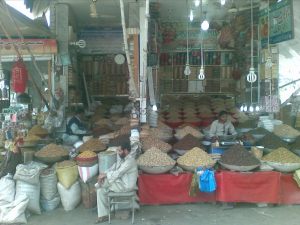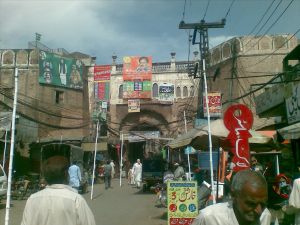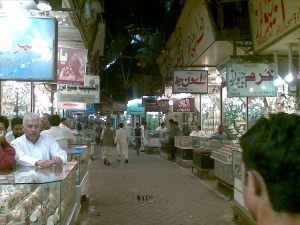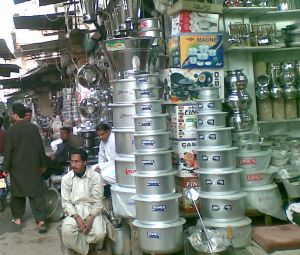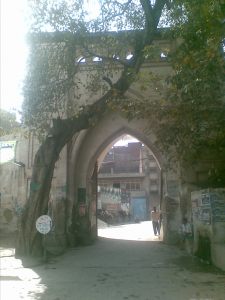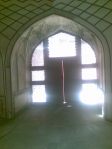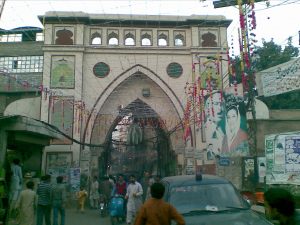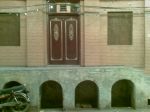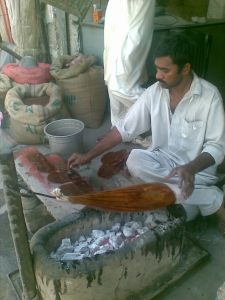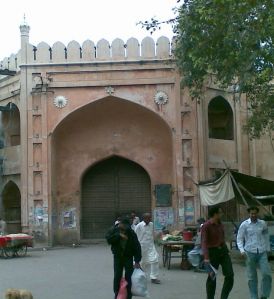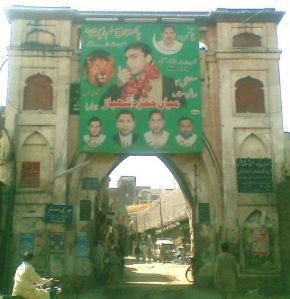|
Gateways to the Past (Gates of Lahore)

The Old Walled City The city of Lahore has seen many remarkable ages and dynasties, and in the narrow lanes of the old city you can still find traces of the city’s glorious past. It is not difficult to envision the majesty of the long gone era by looking at the many imposing structures that are still standing tall while some have crumbled to dust. Among such structures worth mentioning are the gates of Lahore. For safety purposes, the Old City of Lahore was enclosed by a 9 meter high brick wall and had a rampart running around it, for that reason it’s also known as “Walled city” or “Androon-e-Shehar” (inner city). The 13 gates made of wood and iron, gave access to the city and were closed in the evening. Some historians claim that the gates were 14 in number; nonetheless this perspective is not supported at large. The way these historical gates were designed truly acknowledges the majesty of the bygone empires. These gates were constructed during Emperor Akbar’s rein (1584 -1598). During Ranjit Singh’s (the first Maharaja of the Sikh Empire 1799 to 1849) times, the fast falling walls were rebuilt in 1812. All of these gates continued to exist until the 19th century. In an attempt to deteriorate the defense of the city, the British demolished almost all of the gates except Roshnai Gate. Some were rebuilt in simple structures, except for Delhi Gate and Lahori Gate. Only 6 of these ancient gates are present these days that include Roshnae, Delhi, Shairanwala, Bhati, Kashmiri and Lahori (Lohari).
Mochi Darwaza:
Mochi Gate-Dry Fruit Shops Located in south, Mochi gate is yet another significant mark of Mughal Empire. The name of the gate in fact is marred form of “Moti” (pearl) or “Morchi” (Trench Soldier). Pandit Moti Ram, a guard in the reign of Akbar used to watch over the gate. He remained associated with his job till he breathed his last. For that reason it was named after him. Nevertheless, some historians assert that “Mochi” is the marred form of Urdu word “Morchi” which means “Trench Soldier”. It is further supported by the fact that the different streets (Mohallas) which still bear their old names are the Mohalla Teer-garan (arrow craftsmen), Mohalla Kaman-garan (bow craftsmen). On the immediate right of the gate, there exists Mochi Bagh which is one of the major places for political get together in Lahore. Many political, processions and gatherings take place here. Dried fruit markets, kites shops and that of fireworks are the splendor of this historical gate. Fazal Sweet House is the famous sweet shop of the area. Besides, Kabab of this particular gate are also unbeatable. The gate is also a prominent roadway for some reputed Havelis of the Mughal Empire. They include Mubarak Haveli, Nisar Haveli and Laal Haveli etcetera. A number of Imam Bargahs (sacred place of Shia sect) are also located in different Havelis. A big mourning procession appears from Nisar Haveli every year on 10th of Moharam. “Das Kulcha with Lonchara” is the mouthwatering breakfast prepared inside the gate from decades. Lahori Darwaza (Lohari Darawaza):
Lahori Gate The oldest gate of the walled city, Lahori gate is located in south and wrongly pronounced as “Lohari” gate. The gate was named after the city Lahore. Since Delhi and Kashmiri gates were named just because they faced Delhi and Kashmir respectively, Lahori gate also derived its name in quite similar pattern. Actually during Hindu Raj, “Ichra” (area name of Lahore) was supposed to be the actual Lahore. As the gate faced towards it (Ichra), consequently it was named as “Lahori Dawaza”. However, another school of thought acclaims that “Lohari” comes from Urdu word “Loha” which means “Iron”.
Gigantic Gate of Lahori Darwaza According to this school of thought, a number of “Lohars” (Blacksmiths) had their shops just outside the gate, for that reason the gate is known as Lohari gate. Nevertheless, the former myth is highly acknowledged than the later one. History asserts that during the time of Mahmood Ghaznavi when Malik Ayaz reconstructed the town, the accommodation of the city was first populated about this gate. When Maharaja Ranjit Singh surrounded Lahore with a large force, it was Muhkim Din Chaudary, who was in charge of Lahori Gate in those times. He connived with Raja and opened it secretly for him and in this way Raja took possession of the city. Currently inside the gate there are innumerable typical Lahori spicy-cum-heavy food spots. Haji Sahib Nahari walay, Sheikh Chathara and Sweets, Mehar Bashir Halwae and Hafiz Channay are some of the most famous food spots of the area. Groups and groups of people come here to relish the scrumptious food and witness the glory of historical buildings of Mughal era.
Majesty of Muslim Majid (inside view) Mar-7 Just outside the gate, is located a beautiful mosque named as Muslim Masjid. Many flower shops are sited in the shelter of the mosque, which sell flowers and garlands of every kind. Behind the gate once there stood a brick fort called Kacha Kot. Biggest optical market of Lahore is also located here. One of the biggest and dazzling bazaars of Lahore, Anar Kali, is situated just across the Lahori Darwaza. The bazaar is extremely popular among middle class group for a variety of stitched and unstitched clothes, shoes and crockery etcetera. A large number of tourists are also seen visiting the area. The tomb of Qutb-Ud-Din Aibak, first Muslim ruler of Subcontinent, is also adjacent to Anarkali Bazaar.
Tomb of Qutab-ud-Din Aybak, adjacent to Anarkali Baazar, near Lohari gate During old times, the gate was also used as a roadway for the travelers coming from Multan. Among the few city gates which the government refurbished, Lahori and Bhatti Gates still retain their original form and that too up to some limited extent. Shah-Alam Gate
Soha Bazaar near Rang Mahal, Shah Almi gate Located in south, Shah Alam gate is colloquially known as “Shah-Almi”. It is the gateway towards one of the busiest and financially giant markets of Lahore, which primarily trade in wholesale rates. From jewelry to garments, crockery to grocery, ceramic vessels to that of iron, wedding accessories to that of offices, electronic gadgets to toys for kids you’ll find almost each and every thing found under the globe here. In this regard, Rang Mahal is the pertinent bazaar of the gate which remains jam-packed throughout the day. “Soha Bazaar” (Gold Market) is located just beside Rang Mahal. A large number of goldsmiths in narrow streets of the bazaar are running their inherited business from since partition. Spilling over with glistening light of gold and yellow bulbs, about 400 shops located in the Bazaar present a bridal look at night. Kanari Bazaar is yet another worth mentioning bazaar of the area. As the name suggests this bazaar is specifically meant for fine open fabrics made by weaving thread in a variety of patterns (laces). Young lasses love to visit
Paranda (Girl's Attire) Shop in Dabi Bazaar in Rang Mahal the bazaar as it has every thing to serve their star-studded and scintillating attires, specially that of weddings. Just beside Kanari Bazaar, a roadways leads to Chata Bazaar. This bazaar is specially meant for Khussa (footwear name), Peshawari and Kohla pori Chappal.. Gumtee and Dabi Bazaars of the area are popular for bangles. In short, the area is complete menu for chirpy girls from where they can find each and everything of their interest and that too on economical rates. Number one cloth market of Asia, Azam Cloth Market is situated in the very same area. A roadway also leads to the market from Kahsmiri gate. This particular market carries about 16000 shops of clothes. Traders from all over the country come and buy a range of clothes. If you are fond of old archaeological or new pots of steel, copper, bronze;
Kasera Bazaar Kasera Bazaar has the best for you to serve. After tiresome shopping throughout the day, if the army of mouse starts marching in your tummy, don’t worry! The bazaar has to serve something lip smacking for its visitors as well. Pathoras of Rang Mahal and Kulfi, serve as recognition of the area this particular gate. Coming towards the history of the gate, Shah-Alam Gate was named after the son and successor of Aurangzaib, Muazzam Shah Alam Bahadur Shah (1707 to 1712), a generous emperor. He was one of the most popular emperor in Punjab. This gate was formerly called the Bherwala Gate. During the partition riots in 1947, it was burnt to ashes, only the name remains now. Soneri (golden) Masjid, Onchi Masjid are the historical mosques of this gate.
Kashmiri Darwaza:
Kashmiri Gate Situated in north, Kashmiri gate is so named because of its opening towards valley Kashmir. Just like tribe “Bhat” in Bhatee Gate, local natives of the gate belong to a tribe known as “Kashmiri”. The gate is adjacent to Delhi Darwaza, one of the most famouse gates of Lahore. Inside the gate there is a shopping area called “Kashmiri Bazaar”. It is a widespread bazaar with narrow markets and alleyways in every corner. A roadway to Wazeer Khan Mosque is also accessed from the bazaar. A big market of children shoes is also situated in this gate. The gate also leads to a roadway towards Asia’s number one cloth market, Azam Cloth market. It contains more than about 16000 shops of clothes. A girl’s college is also located in an old yet majestic haveli of a shah. Furthermore, the current condition of the historic gate is just pathetic. Advertisements of different shops and banners of some political parties are heavily costing the splendor of the Mughal art. Delhi Darwaza:
Delhi Gate One of the most famous gates of Lahore, Delhi Darwaza (gate) was built by third Mughal Emperor Akbar the great. This gate is situated on east and has its opening towards Delhi, the capital of Mughal dynasty. During old times, this particular gate was considered to be the busiest one of Lahore. Just inside, on the left of the gate you would be awe-surprised seeing magnificent Shahi Hamam (Royal Washroom), built by Hakim Ilmuddin. Covering an area of 1110 SQ M, the single story Hamam was built in typical Mughalic style. Inside the gate, there are a number of
Shahi Hamam-Enterance historical buildings, old streets and markets. Wazeer Khan Mosque, another majestic inheritance from Mughal Empire, exists within the gate. The tomb of Hazrat Meran Badshah also exists in the courtyard of the mosque. Upside the gate, there is an archaeological styled building that is currently being used as a government school for girls. The gate also contains a number of old havalies to fetch the tourists in to a state of surprise. A big cloth market is located around Delhi gate. The gate also includes a holy place for Hindus “Shawala Baba Bhakar Guru”. Across the gate, there is Landa Bazar, where recycled attires are sold at amazingly economical rates. Interestingly, sometimes the stuff of the attires is quite better than that of new ones. Akbari Darwaza: Very first in alphabetical order, Akbari gate was located in eastern side. It was named after Jalal-Ud-Din Muhammad Akbar (1542-1605). With the passage of time the gate got dilapidated. During the reign of English though it was renovated, nevertheless currently once again it has lost its magnificence. Close to this gate, the royal leader also established a market, which is known as “Akbari Mandi” (Akbari Market). It is the biggest wholesale and retail market of Lahore, in which food grains of all kinds are traded. It’s a widespread market with hundreds of wholesale and retail shops. Bhatti Darwaza:
Bhatti Gate It was the time when Mehmood Ghaznavi defeated Raja Jay Pal, the gate was named after an ancient Rajput tribe resided here, “Bhat” (Bhatti). Bhats invaded the quarters of the area in old times. Bhatti gate is one of the two gates that are located on the west. It is renowned because of its typical Lahori food. In fact, food is the identity of Bhatee and Lahori gate. A large number of epicures visit and relish the appetizing and crispy Lahori food available here 24/7. A museum, where there are a number of ancient remains of different old times, is located near Bhatti gate. “Onchi Masjid”, another historical mosque is situated nearby the Lahori and Bhatti gate. “Bazaar-e-Hakiman”, as the name suggests is a bazaar that was specifically reserved for Hakims. In ancient times, exceedingly recognized Hakims of the city used to live here for that reason the Bazaar was named after them.
Place where Iqbal used to study and meet his friends, located inside Bhatti Gate It’s not less than an honour for the natives of the gate that the national poet of the country and great scholar of all times, Dr. Muhammad Allama Iqbal used to live here during his graduation. A small sitting where Iqbal used to study and had daily meetings with his comrades still exists in Bazaar-e-Hakiman. The gate is also renowned for bringing up some eminent Pahalwans (wrestler) of the country. Kala Maro, a famous pahalwan (wrestler) belongs to the gate in discussion. Masti Gate:
A giant historic building of Mughal era, currently used for a school named after Queen Victoria On east, Masti Gate is located behind Lahore Fort. Research asserts that the name of the gate is deteriorated form of word, “Masjidi” (pertaining to Mosque). The mosque of Mariam Makhani, the mother of Emperor Akbar, is located in its immediate locality. Nevertheless, another school of thought acclaims that the gate was named after Masti Baloch, who was appointed as guard on the gate. The area primarily filled by shoe vendors. Just like Lohari and Bhati, the gate is also renowned for its best quality heavy food. Milk shops of the area are eminent ones and the milk available here is full of taste. A shake that is known as, “Rabri wala Dodh” is equally popular among elders and children. Addition of almonds, pistachio nuts, kulfi (ice-cream) and vermicelli give a yummy touch to the milk. Zakki Gate (Yaki Gate): One of the four gates located on eastern side, Zakki gate has a history of its own that is bit astounding as well. It was named after a martyr saint, “Zakki”. History states that the great saint was fighting against “Tataraies” from north that got beheaded brutally. It is said that even after his head was beheaded at the gate, his trunk continued fighting for sometime and then fell nearby. Head and the trunk of the saint were buried at their fallen places “separately” and both are venerated to this day. There is school for blinds situated nearby the gate. Besides, there are a number of Havelis located in and around the gate. A number of temples are also located in and around Yakki Gate. Mori Darwaza:
Worker busy in Lakh-wooden Polish preparation Amid Lahori and Bhati, there used to be the smallest gateway called, Mori Darwaza. Though it wasn’t a particular gate as the other twelve ones but even then it’s included among the great series constructed during the Mughal Empire. In Urdu, word “Mori” is referred to a “small hole”. Since it was a small gateway for that reason it is named, “Mori Gate”. In the evening when all of the twelve gates were closed for security purposes then this particular opening gave access to the walled city. Moreover, it was also used as outlet for the refuse and the sweepings of the city. Inside the gate an alley leads to a square named Chowk Jhanda where during the olden times used to be the best store of desi condiments named, “Upal store”. People from all over the city remained queued in order to buy grocery from here. Behind the gate once stood a narrow street which leads to an open area. This open area was once a large garden and the haveli of Nau Nihal Singh. Today, though there is no remnant of that garden but the haveli lives to tell the tale along with some of its ornamentation. Just across the gate there also exists the biggest market for knowledge seekers, Urdu Bazaar, where a number of book lovers daily visit in order to quench their thirst of knowledge. A school that is named after Queen Victoria is also situated here and is mentioned in golden chapters of the long-gone empire. The tribe residing here since Sikh Empire is known as “Kamboo”. Representing typical Lahori civilization, people of the vicinity are extremely convivial and welcoming. Interestingly, there has never been recorded a single FIR (First Investigation Report) of robbery in this area. Here one might be surprised seeing wide opened door of the homes, without any fear of security.
Fish Market-Mori Gate This significant gateway located on south is renowned for its giant fish market. All species of fish are brought and sold here. The biggest surgical goods market of Lahore also exists in the very same gate. The natives of the gate are also recognized for the production the best quality wooden-furniture polish, commonly known as “Lakh“. Good quality kites and twines are also available inside the gate. People from all over the world specially come to mark Basant night here. Texali Gate: To access the walled city through heavily fortified brick wall, one of the two gates built in the west, is called “Texali Gate”. The gate is so called because of a Taxal (Royal Mint) that used to exist quite near to the gate. However, both Mint and the gate are no more today. Currently, the gate is frequently visited by food lover Lahories as the bazaar around it has to serve best quality typical Lahori breakfast that includes Pa’ay of Fazal Din colloquially known as “Phajja” and Halwa Puri of Taj Mehal and Shahbudin Halwai. The bazaar is also renowned for the musical instruments (including Dhol, Tabla etc.) that are made and sold here. Besides, a large number of people from all over the city specially visit Sheikuprian Bazaar to buy best quality Khussa, Peshawari and Kohla-Puri Chappal. Madhu Lal, a well-renowned saint was born in Texali gate in 1539. A renowned area of the times, Pani wala Talab and Gurdwara Lal Khooh (a sacred place of Sikhism followers) are also located near to the gate. Roshnai Gate:
Roshnae Gate Located in south on the map, Roshnai gate (Gate of Lights) lies between Shahi Qila (Lahore Fort) and Badshahi Mosque. The Gate of Lights is the gate that still is in fine condition and lives through its original looks. It was the main entrance from fort to city and was specifically used for omerahs, courtiers, royal servants and retinues. In the evenings the gate was lit up, hence it’s named “Raushnai Darwaza”. Adjacent to the gate, Hazuri Bagh is another spot that is worth mentioning. This garden was built by Maharajah Ranjit Singh in 1813 to celebrate the capture of the famous Koh-i-Noor Diamond from Shah Shujah of Afghanistan. In the center of the garden there stands the Hazuri Bagh Baradari. Featured with marble, the current condition of the Baradari is quite pathetic. The Mausoleum of Muhammad Iqbal and the Samadhi of Ranjit Singh are all located in the garden. The vicinity around it is well known because of the bazaar called Shahi Mohala. Khiziri Gate (Shairanwala Gate):
Shairanwala Gate Hazrat Khwaja Khizr Elias, a great saint of the times, was known as “Amer-ul-Bahar” (commander of water). He had special association with running waters and was the discoverer of “water of immortality”. The gate was named “Khiziri” gate after his name. It is one of the three gates located in the north side of the city. In old times river Ravi used to flow by the walled city Lahore and sea-transportation (ferry) used to take place near to this gate. When Maharaja Ranjit Singh (also known as Sher-e-Punjab) got hold of the city, he kept two domesticated lions in a cage for the protection purposes on the gate. In that context the gate was named as “Sheranwala gate” (Lion’s gate). The Italian traveler Niccola Mannuchi who visited Lahore in 1667 named it Qadri Gate, however historians has not come across the reason behind it yet. Life inside the gate truly describes traditional old Lahori way of living. Narrow bazaar brimming with a variety of necessities of daily life remains open till late at night. There is also a famous Government School for Deaf and Dumb Khizri Mohala (Society). The current condition of the gate and its structure is in extremely pathetic. The lime plaster and the paint have been depreciated completely. A number of cracks, billboards and advertisements on the walls are cursing the majesty of the Mughal Empire. Life inside the walled city is exceptionally interesting. If one observe bit profoundly, it’s utterly opposite to that of the modern urban areas. Most of the areas in and around the gates are brimming with dirtiness and pollution but the hearts of its inhabitants, are the best example of cleanliness. Unlike us, they people are convivial, hospitable, very cooperating and in short full of beans. Even though, vicious circle of poverty has surrounded them cruelly but still they are united. The entire Mohala is like a family, and everyone is close to each other, share their happiness and sorrows just like a family member. The historic gates of Lahore are the precious inheritance of these Lahories. Though most of the gates have lost their shine, their beauty but still they are alive to witness the glory and magnificence of the bygone empires.
(Dawn YW, Sep 26-2009) (PS: Due of shortage of space the content of the article had to be shortened in the newspaper. However the blog contains the complete write up)
|
||
